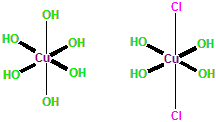Dicopper chloride trihydroxide
Dicopper chloride trihydroxide is a chemical compound with the formula Cu2(OH)3Cl. It is known for its use as a fungicide, algicide, and wood preservative. This compound is also referred to by its common name, tribasic copper chloride (TBCC), and is notable for its role in agricultural applications and material preservation.
Properties[edit | edit source]
Dicopper chloride trihydroxide is characterized by its blue-green color, which is typical of copper-containing compounds. It is poorly soluble in water, which is a desirable property for its use in outdoor applications where rainwater could otherwise dissolve and wash away the active ingredient too quickly. The compound's chemical structure allows it to release copper ions slowly, providing long-lasting protection against fungi, algae, and other pests.
Synthesis[edit | edit source]
The synthesis of dicopper chloride trihydroxide involves the reaction of copper(II) chloride (CuCl2) with sodium hydroxide (NaOH) in the presence of water. This reaction produces a precipitate of Cu2(OH)3Cl, which can then be filtered and dried for use. The process is carefully controlled to ensure the purity and consistency of the final product.
Applications[edit | edit source]
Agriculture[edit | edit source]
In agriculture, dicopper chloride trihydroxide is used as a fungicide to protect crops from fungal infections. It is effective against a wide range of fungal pathogens and is used in the treatment of fruits, vegetables, and ornamental plants. Its slow release of copper ions ensures prolonged protection, reducing the need for frequent reapplication.
Material Preservation[edit | edit source]
As an algicide and wood preservative, dicopper chloride trihydroxide is applied to surfaces vulnerable to algae growth and wood decay. It is commonly used in the treatment of outdoor wood structures, such as decks, fences, and siding, to extend their lifespan and maintain their appearance. The compound's resistance to water solubility makes it particularly suited for these applications.
Safety and Environmental Impact[edit | edit source]
The use of dicopper chloride trihydroxide is regulated due to concerns about its potential environmental impact and toxicity to aquatic life. When used as directed, it is considered safe for humans and the environment. However, measures should be taken to minimize runoff and prevent the compound from entering waterways, where it can be harmful to fish and other aquatic organisms.
Conclusion[edit | edit source]
Dicopper chloride trihydroxide is a valuable compound in the fields of agriculture and material preservation, offering effective protection against a variety of pests and pathogens. Its unique properties and applications make it an important tool in maintaining the health and longevity of plants and materials.
Navigation: Wellness - Encyclopedia - Health topics - Disease Index - Drugs - World Directory - Gray's Anatomy - Keto diet - Recipes
Search WikiMD
Ad.Tired of being Overweight? Try W8MD's physician weight loss program.
Semaglutide (Ozempic / Wegovy and Tirzepatide (Mounjaro) available.
Advertise on WikiMD
WikiMD is not a substitute for professional medical advice. See full disclaimer.
Credits:Most images are courtesy of Wikimedia commons, and templates Wikipedia, licensed under CC BY SA or similar.
Contributors: Prab R. Tumpati, MD





